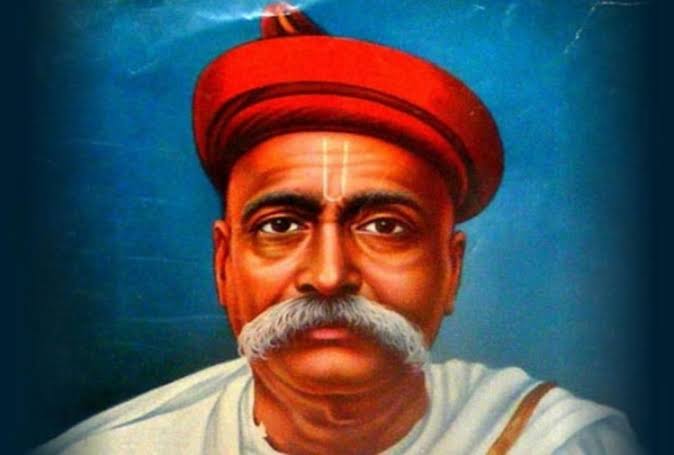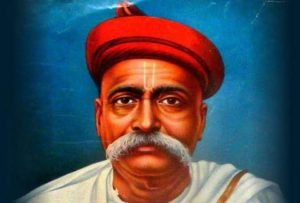Bal Gangadhar Tilak was an Indian nationalist and an independence activist mentioned as the first leader of the Indian Independence Movement The British colonial authorities called him “The father of the Indian unrest.”
He was also conferred with the title of “Lokmanya“, which means “accepted by the people (as their leader)”. Mahatma Gandhi called him “The Maker of Modern India“. Tilak was one of the first and strongest advocates of Swaraj.
He is known for his quote in Marathi: “Swarajya is my birthright and I shall have it!”.
He formed a close alliance with many Indian National Congress leaders including Bipin Chandra Pal, Lala Lajpat Rai, Aurobindo Ghose, V. O. Chidambaram Pillai, and Muhammad Ali Jinnah.
Table of Contents
Contents:
- Early life.
- Political carrier.
- Indian national congress.
- Imprisonment.
- Social reforms.
- Newspapers and Books.
- Social views.
- Death.
- Legacy.
Early life:
- Keshav Gangadhar Tilak was born on July 22, 1856. in Ratnagiri, a small coastal town in south-western Maharashtra.
- His father, Gangadhar Shastri was a noted Sanskrit scholar and school teacher at Ratnagiri.
- His mother’s name was Parvati Bai Gangadhar.
- In 1871 Tilak was married to Tapibai who was later rechristened as Satyabhamabai.
- After graduating from Deccan College, Pune, in 1877 in Sanskrit and Mathematics, Tilak studied L.L.B. at the Government Law College, Bombay.
- He received his law degree in 1879.
- Though he was among India’s first generation of youths to receive a modern, college education, Tilak strongly criticized the educational system followed by the British in India.
- He protested against the unequal treatment of the Indian students compared to their British peers and its total disregard for India’s cultural heritage.
- He started the Deccan Educational Society with college batchmates, Vishnu Shastry Chiplunkar and Gopal Ganesh Agarkar for the purpose of inspiring nationalist education among Indian students.
- Parallel to his teaching activities, Tilak founded two newspapers ‘Kesari’ in Marathi and ‘Mahratta’ in English.
Political career:
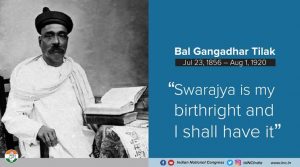
- Tilak had a long political career agitating for Indian autonomy from the British rule. Before Gandhi, he was the most widely known Indian political leader.
- Tilak was considered a radical Nationalist but a Social conservative.
- He was imprisoned on a number of occasions that included a long stint at Mandalay.
- At one stage in his political life, he was called “the father of Indian unrest” by British author Sir Valentine Chirol.
- Tilak joined the Congress in 1890.
- He was opposed to moderate ways and views and had a more radical and aggressive stance against British rule.
- He was one of the first advocates of Swaraj or self-rule. He gave the slogan, “Swaraj is my birthright and I shall have it.”
- He believed that no progress was possible without self-rule.
- He was part of the extremist faction of the INC and was a proponent of boycott and Swadeshi movements.
Indian National Congress:

- Gangadhar Tilak joined the Indian National Congress in 1890.
- His strong opposition to the moderate views of the party on self-rule. He maintained that simple constitutional agitation in itself was futile against the British. This subsequently made him stand against the prominent Congress leader, Gopal Krishna Gokhale.
- Tilak wholeheartedly supported the Swadeshi (Indigenous) movement and Boycott of British goods. But his methods also raised bitter controversies within the Indian National Congress (INC) and the movement itself.
- Tilak and his supporters came to be known as the extremist wing of the Indian National Congress Party.
- Tilak’s endeavors were supported by fellow nationalists Bipin Chandra Pal of Bengal and Lala Lajpat Rai of Punjab.
- The trio came to be popularly referred to as the Lal-Bal-Pal.
- In the 1907 national session of the Indian National Congress, massive trouble broke out between the moderate and extremist sections of the Indian National Congress Party. As a result of which, the Congress split into two factions.
- Tilak re-joined the INC in 1916, after having split earlier.
- He was one of the founders of the All India Home Rule League, along with Annie Besant and G S Khaparde.
- For his political ideals, Tilak drew heavily from the ancient Hindu scriptures.
- He called for people to be proud of their heritage. He was against the blatant westernization of society.
- He transformed the simple Ganesh Puja performed at home into a social and public Ganesh festival.
- He used the Ganesh Chaturthi and Shiv Jayanti (birth anniversary of Shivaji) festivals to create unity and a national spirit among the people. Unfortunately, this move alienated non-Hindus from him.
- The Sarvajanik Ganeshotsav as popularised by him since 1894 is still one of the biggest festivals of Maharashtra.
Imprisonment:
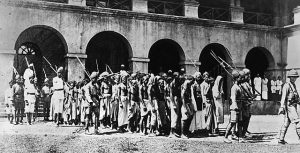
- Tilak protested against the oppressive nature of the British efforts and wrote provocative articles on it in his newspapers.
- His article inspired the Chapekar brothers and they carried out the assassination of Commissioner Rand and Lt. Ayerst on June 22, 1897.
- As a result of this, Tilak was imprisoned for 18 months on Sedition charges for inciting murder.
- During 1908-1914, Bal Gangadhar Tilak spent had to undergo six years of rigorous imprisonment in Mandalay Jail, Burma.
- He openly supported the revolutionaries Khudiram Bose and Prafulla Chaki’s efforts to assassinate Chief Presidency Magistrate Douglas Kingsford in 1908.
- He continued to write during his years of imprisonment and the most prominent of which is Gita Rahasya.
- Following his growing fame and popularity, the British government also tried to stop the publication of his newspapers.
- His wife died in Pune while he was languishing in Mandalay prison.
Newspapers and books:
Newspapers:
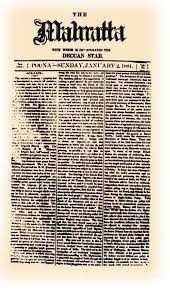
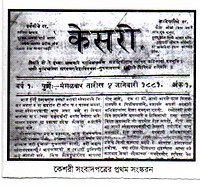
- Bal Gangadhar Tilak published two newspapers -‘Mahratta’ (English) and ‘Kesari’ (Marathi).
- Both the newspapers stressed on making the Indians aware of the glorious past and encouraged the masses to be self-reliant.
- the newspaper actively propagated the cause of national freedom.
Books:
- In 1903, he wrote the book The Arctic Home in the Vedas. In it, he argued that the Vedas could only have been composed in the Arctics, and the Aryan bards brought them south after the onset of the last ice age. He proposed a new way to determine the exact time of the Vedas.
- In “The Orion”, he tried to calculate the time of the Vedas by using the position of different Nakshatras. The positions of the Nakshatras were described in different Vedas.
- Tilak wrote “Shrimadh Bhagavad Gita Rahasya” in prison at Mandalay – the analysis of ‘Karma Yoga’ in the Bhagavad Gita, which is known to be a gift of the Vedas and the Upanishads.
Social views:
- Despite being a nationalist radical leader, Bal Gangadhar Tilak’s social views were conservative.
- He was against Hindu women getting modern education.
- He opposed the age of consent bill initially in which the age of marriage of girls was proposed to be raised from 10 to 12.
- Even though he was okay with this raising of age, he saw this act as interference in the social and religious life of Indians by the British.
- Tilak encouraged the Swadeshi movement and the Boycott movement. The movement consisted of the boycott of foreign goods and also the social boycott of any Indian who used foreign goods.
- The Swadeshi movement consisted of the usage of natively produced goods. Once foreign goods were boycotted, there was a gap that had to be filled by the production of those goods in India itself.
- Tilak said that the Swadeshi and Boycott movements are two sides of the same coin.
Death:
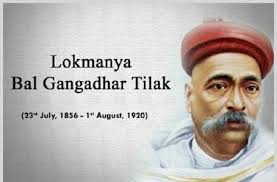
- Tilak was so disappointed by the brutal incident of Jalianwala Bagh massacre that his health started declining. Despite his illness, Tilak issued a call to the Indians not to stop the movement no matter what happened.
- Tilak suffered from diabetes and had become very weak by this time. In mid-July 1920, his condition worsened and on August 1, he passed away.
Legacy:
- He was a social conservative.
- He was a devout Hindu and spent a lot of his time writing religious and philosophical pieces based on Hindu Scriptures.
- He was one of the most popular influencers of his time, a great orator and a strong leader who inspired millions to his cause.
- Today, Ganesh Chaturthi, started by Tilak, is considered as the prime festival in Maharastra and adjacent states.
- Tilak has featured in a number of biographies for being an iconic figure of Indian Freedom struggle.
- The Marathi newspaper started by Tilak is still in circulation although now it is a daily instead of a weekly during Tilak’s time.
- The Deccan Education Society that Tilak founded with others in the 1880s still runs Institutions in Pune like the Fergusson College.
- The Swadeshi movement started by Tilak at the beginning of the 20th century became part of the Independence movement until that goal was achieved in 1947.
- One can even say Swadeshi remained part of Indian Government policy until the 1990s when the Congress Government liberalized the economy.
- Tilak Museum is listed among the most important museums in the city of Pune. Located in his residence in the Narayan Peth area of Pune, Kesari Wada, the famous historical monument houses.
- Tilak Smarak Ranga Mandir, a theatre auditorium in Pune is dedicated to him.
- In 2007, the Government of India released a coin to commemorate the 150th birth anniversary of Tilak.
- Tilak said, “I regard India as my Motherland and my Goddess, the people in India are my kith and kin, and loyal and steadfast work for their political and social emancipation is my highest religion and duty”.
- Lokmanya: Ek Yug Purush is a movie on his life.

